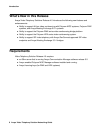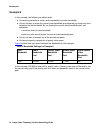
Introduction
12 Avaya Video Telephony Solution Networking Guide
Example 4
In this example, you do not want to use too much bandwidth on audio. You want to reserve most
of the bandwidth for video, but you want to allow a few audio calls to keep costs down. You have
a small number priority users. Figure 4
shows how you would configure the bandwidth for this
example.
The settings in table will allow a few audio calls and one or two priority calls depending on the
bit rate. After the audio pool runs out of bandwidth, the calls will be forced to take another route
since the since the normal video bandwidth pool is not shared. If a priority call occurs when all
of the priority video bandwidth is used, it will use any available bandwidth in the normal video
bandwidth pool before using bandwidth from the audio bandwidth pool.
Example 5
In this example, you do not want to use any IP bandwidth for audio. You want to use IGAR for
audio. All IP bandwidth will be used for video. Figure 5
shows how you would configure the
bandwidth for this example.
Since you have allocated no audio bandwidth, audio calls will fall over to the public-switched
telephone network. However, multimedia calls will take audio bandwidth and video bandwidth
from the normal video bandwidth pool.
Table 4: Bandwidth Settings for Example 4
Total
Bandwidth
Audio
Bandwidth
Pool
Priority Video
Bandwidth
Pool
Normal Video
Bandwidth
Pool
Share Normal
Video
Bandwidth
Pool
3 Mb 0.9 Mb 0.6 Mb 1.5 Mb No
Table 5: Bandwidth Settings for Example 5
Total
Bandwidth
Audio
Bandwidth
Pool
Priority Video
Bandwidth
Pool
Normal Video
Bandwidth
Pool
Share Normal
Video
Bandwidth
Pool
3 Mb 0 Mb 0 Mb 3 Mb No


















